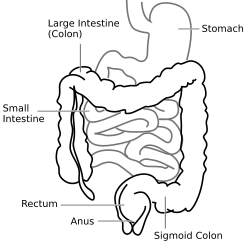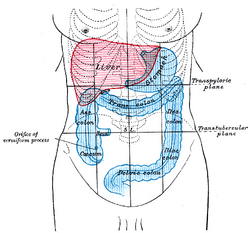Large intestine facts for kids
Quick facts for kids Large intestine |
|
|---|---|
 |
|
| Front of abdomen, showing the large intestine, with the stomach and small intestine in gray outline. | |
 |
|
| Front of abdomen, showing surface markings for liver (red), and the stomach and large intestine (blue) | |
| Latin | intestinum crassum |
| Artery | Superior mesenteric, Inferior mesenteric and Iliac arteries |
| Lymph | inferior mesenteric lymph nodes |
The large intestine is an important part of your digestive system. It's also known as the colon or large bowel. This organ connects your small intestine to the rectum and anus.
Even though it's called "large," it's actually shorter than your small intestine. It's about 1.5 meters (or 5 feet) long. However, it has a wider diameter (it's thicker) than the small intestine.
Contents
What the Large Intestine Does
The main job of your large intestine is to absorb water. It takes water from the food waste that your body can't use. This process helps your body stay hydrated.
After the water is absorbed, the remaining waste material becomes solid. This solid waste is called faeces (or poop). The large intestine stores these faeces until your body is ready to remove them.
When your body removes the waste, it's called defecation. This is how your body gets rid of what it doesn't need.
Parts of the Large Intestine
The large intestine has several different parts. Each part helps move the waste along.
- The first part is the cecum. This is where the small intestine connects.
- Next comes the colon, which is the longest part. The colon has sections that go up, across, and down.
- Finally, the waste reaches the rectum. This is the last stop before the waste leaves your body.
Keeping Your Large Intestine Healthy
Eating a balanced diet is important for your large intestine. Foods with lots of fiber help keep things moving smoothly. Drinking enough water also helps.
Your large intestine is a vital organ. It plays a big role in keeping your body healthy. It makes sure your body gets enough water and removes waste properly.
Images for kids
See also
 In Spanish: Intestino grueso para niños
In Spanish: Intestino grueso para niños






